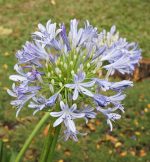 Also called lily of the Nile, this native of the Cape of Good Hope in South Africa is an evergreen tender perennial and a member of the amaryllis family, Amaryllidaceae, that also includes daffodils, clivia, and onion. Plants have a thick fleshy, rhizomatous root system and form a mound of leathery strap-shaped leaves that are glossy, dark green, and 2-3′ long. In summer a stout leafless stem produces a rounded umbel of flowers well above the foliage. Each umbel has 20-30 funnel-shaped flowers with deep blue, purplish, or white petals that have a darker strip down their centers. The flowers are attractive to butterflies and and the flowerheads are good in the vase. Plants are tolerant of salty air and are an excellent choice for seaside gardens as well as mixed borders, cutting gardens, butterfly garden, and containers. In cold climates plants can be brought indoors in fall. This species is rarely available and most plants sold under this name are probably another species. The genus name, Agapanthus, comes from the Greek words agape meaning love, and anthos meaning flower. The specific epithet, africanus, refers to the geographic area of its native habitat.
Also called lily of the Nile, this native of the Cape of Good Hope in South Africa is an evergreen tender perennial and a member of the amaryllis family, Amaryllidaceae, that also includes daffodils, clivia, and onion. Plants have a thick fleshy, rhizomatous root system and form a mound of leathery strap-shaped leaves that are glossy, dark green, and 2-3′ long. In summer a stout leafless stem produces a rounded umbel of flowers well above the foliage. Each umbel has 20-30 funnel-shaped flowers with deep blue, purplish, or white petals that have a darker strip down their centers. The flowers are attractive to butterflies and and the flowerheads are good in the vase. Plants are tolerant of salty air and are an excellent choice for seaside gardens as well as mixed borders, cutting gardens, butterfly garden, and containers. In cold climates plants can be brought indoors in fall. This species is rarely available and most plants sold under this name are probably another species. The genus name, Agapanthus, comes from the Greek words agape meaning love, and anthos meaning flower. The specific epithet, africanus, refers to the geographic area of its native habitat.
Type: Tender perennial
Bloom: Umbels of 20-30 blue, purple or white funnel-shaped flowers in summer
Size: 1.5-2′ H x 2′ W
Light: Full sun (flowering stems lean towards the light so plant in a south facing site.)
Soil: Fertile, consistently moist during the bloom time, well-drained
Hardiness: Zones 8-10
Care: Fertilize once in the spring; deadhead; divide every several years.
Pests and Diseases: None of significance
Propagation: Division, seed (takes 2-3 years to produce a blooming plant from seed)
Companion Plants: Russian sage, red hot poker, Crocosmia ‘Lucifer’
Photo Credit: Wikipedia